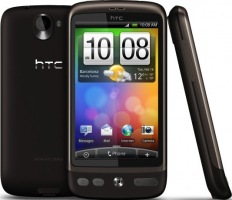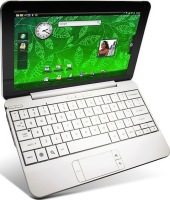MWC 2010: Android everywhere
 At this year's Mobile World Congress(MWC) in Barcelona, while Microsoft announced its Windows Phone 7 Series this week, a number of other companies are announcing their new Android-based devices. The open source Android OS devices, which range from mobile phones and notebooks, to tablets and Internet Devices, include updates to popular well known handsets and several new mobiles.
At this year's Mobile World Congress(MWC) in Barcelona, while Microsoft announced its Windows Phone 7 Series this week, a number of other companies are announcing their new Android-based devices. The open source Android OS devices, which range from mobile phones and notebooks, to tablets and Internet Devices, include updates to popular well known handsets and several new mobiles.
Taiwanese handset manufacturer HTC announced two new mobile phones, including an updated version of the Hero (AKA the T-Mobile G2 Touch), the first Android device that included Flash support. The Legend features a similar design to that of the Hero with a 3.2 inch display and slightly faster processor (600 Mhz vs 528 Mhz). However, instead of a completely plastic body, it uses a unibody aluminium frame and replaces the mini-trackball with an optical trackpad.

![]() The Desire features Flash support and HTC's Sense UI.
The Desire features Flash support and HTC's Sense UI.
Source: HTC
However, the big news from HTC was the announcement of the Desire, its new top of the line device. The new mobile borrows a number of features from the Google Nexus One smartphone, which the company also manufacturers, such as its 3.7 inch AMOLED display and 1 GHz Qualcomm Snapdragon processor. The Desire adds HTC's custom "Sense" user interface (UI) to Android 2.1 and includes support for Flash 10.1.
Both of the HTC handsets run version 2.1 of Android with an updated version of HTC's Sense UI, include a microSD card slot and are expected to arrive in the second quarter of this year. Orange UK will reportedly be offering the Desire on selected pay monthly tariffs in April.
Acer updated its Liquid smartphone lineup with the Liquid e, featuring version 2.1 of Android, 256 MB of RAM and a 768 MHz Snapdragon processor. The device has a 3.5 inch WVGA display, a 5 megapixel auto-focus camera and a built-in GPS and accelerometer. Wireless connectivity includes a 7.2 Mbit/s HSDPA connection, 802.11 B/G Wi-Fi and Bluetooth 2.0.
The Liquid e wasn't the only new Acer handset. The company also announced two new devices – The beTouch E110 and the beTouch E400. The E110 is an entry-level handset that runs Android 1.5 and features a 2.8 inch screen, a 3 megapixel camera, FM radio and a 416 MHz processor. The E400, which runs version 2.1 of Android, has a faster 600 MHz processor and a larger 3.2 inch screen. Both mobiles are expected to arrive in March.

![]() HP's Airlife 100 runs Android and includes a 10.1 inch touchscreen display.
In the netbook category, HP continued to show off its Compaq Airlife 100 smartbook. The Airlife 100 features a 1 Ghz Snapdragon processor, a 16GB SSD hard drive and built-in Wi-Fi. Unlike other Android-powered notebooks, such as the Acer Aspire One AOD250, the Airlife 100 also includes a 10.1 inch touch screen and HP is touting a 12 hours of battery life. A wireless 3G data connection will also be available as an option.
HP's Airlife 100 runs Android and includes a 10.1 inch touchscreen display.
In the netbook category, HP continued to show off its Compaq Airlife 100 smartbook. The Airlife 100 features a 1 Ghz Snapdragon processor, a 16GB SSD hard drive and built-in Wi-Fi. Unlike other Android-powered notebooks, such as the Acer Aspire One AOD250, the Airlife 100 also includes a 10.1 inch touch screen and HP is touting a 12 hours of battery life. A wireless 3G data connection will also be available as an option.
Computer manufacturer Dell confirmed that its Dell Mini 5 tablet, previously shown at CES as a prototype, will ship with "something newer" than Android 1.6 when its finally released. The Mini 5 features a 5 inch touch screen, a 5 megapixel camera and built-in Wi-Fi and 3G. Price and final release date have yet to be announced.
Other companies showing off new Android handsets included Huawei and Motorola. Huawei unveiled four new handsets and a 7 inch Internet Device called the SmaKit S7. Motorola showed off its Android portfolio, including the Milestone (also known as the Motorola Droid on Verizon in the US) and BACKFLIP handsets, and introduced its new QUENCH smartphone which which features the company's MOTOBLUR interface. WIth all of these new Android-based devices, this year is shaping up to be a big year for Google's open source mobile operating system.
See also:
- Android devices sweep CES 2010, a report from The H.
(crve)
![Kernel Log: Coming in 3.10 (Part 3) [--] Infrastructure](/imgs/43/1/0/4/2/6/7/2/comingin310_4_kicker-4977194bfb0de0d7.png)

![Kernel Log: Coming in 3.10 (Part 3) [--] Infrastructure](/imgs/43/1/0/4/2/3/2/3/comingin310_3_kicker-151cd7b9e9660f05.png)
















